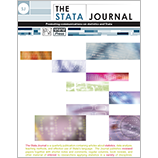Randomization inference with Stata: A guide and software
Simon Heß
Goethe Universität Frankfurt am Main
Faculty of Economics and Business Administration
Frankfurt, Germany
[email protected]
|
Abstract. Randomization inference or permutation tests are only sporadically used in
economics and other social sciences—this despite a steep increase in
randomization in field and laboratory experiments that provide perfect
experimental setups for applying randomization inference. In the context of
causal inference, such tests can handle problems often faced by applied
researchers, including issues arising in the context of small samples,
stratified or clustered treatment assignments, or nonstandard randomization
techniques. Standard statistical software packages have either no
implementation of randomization tests or very basic implementations. Whenever
researchers use randomization inference, they regularly code individual program
routines, risking inconsistencies and coding mistakes. In this article, I show
how randomization inference can best be conducted in Stata and introduce a new
command, ritest, to simplify such analyses. I illustrate this approach’s
usefulness by replicating the results in Fujiwara and Wantchekon (2013,
American Economic Journal: Applied Economics 5: 241–255) and
running simulations. The applications cover clustered and stratified
assignments, with varying cluster sizes, pairwise randomization, and the
computation of nonapproximate p-values. The applications also touch upon
joint hypothesis testing with randomization inference.
View all articles by this author:
Simon Heß
View all articles with these keywords:
ritest, randomization inference, permutation tests, treatment effects, causal inference
Download citation: BibTeX RIS
Download citation and abstract: BibTeX RIS
|
